Working with Words: Word 2007/10/13 |
 |

| Intro |  |
 |

| Before you start |  |
 |

| Project 1: Word Basics |  |
 |

| Project 2: AutoTools |  |
 |

| Project 3: Brochure |  |
 |

| Project 4: Report |  |
 |

| Glossary |  |
 |

| Appendix |  |
 |

There are a number of actions that Word can take automatically that are part of the AutoCorrect feature. These include automatically correcting spelling, creating bullet or number lists, replacing text with a text block or a symbol, or changing the formatting. A lot that we used to consider AutoFormatting is now included as a type of AutoCorrection.
The Help documents for Word will be very important to you as you learn about Word's features. They contain the answers to many of your questions. It takes some practice to learn how to use Help, however. Practice makes perfect, so you will now get some practice in using Help and applying what you learned.
The Step-by-Step section below will guide you to use Help to find out about some of the automatic features of Word. These automatic behaviors are very helpful, but sometimes they are too helpful! You need to learn what Word thinks it is doing, so you won't think that you are the one going crazy!
| |
Step-by-Step: AutoCorrect |
|
| What you will learn: | to search to find a Help article to use the AutoCorrect dialog to use AutoCorrect features in a document to use AutoComplete to use the AutoCorrect Options button to use the AutoFormat dialog to close a document without closing Word |
Start with: ![]()
![]() (Word is open with a blank document.)
(Word is open with a blank document.)
If you worked through the lessons in Working with
Windows, you already have used a flash drive and put several folders
and files on it.
![]() Spare flash drive: Eventually your flash drive may get full
and these small drives are easy to lose, so keep a spare flash drive handy. Don't delete
your work until after it has been graded!
Spare flash drive: Eventually your flash drive may get full
and these small drives are easy to lose, so keep a spare flash drive handy. Don't delete
your work until after it has been graded!
Check it out! If you did the lessons on Windows, your Class drive should currently contain at least the following folders and files: If you did the lessons on Windows, your Class drive should currently contain at least the following folders and files:
|
|
|
Working with Windows -
|
Working with Windows 10
|
While the files you saved in the Windows lessons will not be used again, you do need the subfolders word project1, and word project2. You will make more folders as you go along through these lessons.
It's OK to have other files and folders on your Class device. Just keep a tidy set of folders and be sure you don't fill up the drive. Those MP3 files and videos eat up a lot of space!
Word has the ability to automatically fix some of the most common typing mistakes and to automatically insert symbols when you type certain combinations of characters. It can be quite a surprise if Word "fixes" something and you weren't expecting it. You can turn off some of this automation if it "corrects" things that you don't want corrected. Let's look at Word's Help to see what we can learn about the AutoCorrect feature.

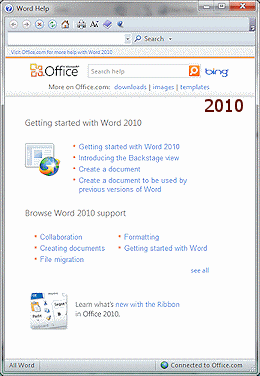
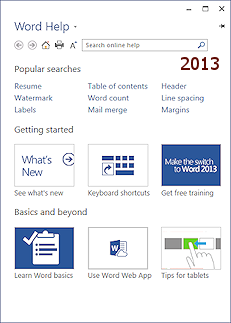
This window will behave similarly in the three versions, but the documents will be
somewhat different.
![]() Default Help window: By default the Help window opens without showing a table of contents
in a Navigation pane. But, if
you open the table of contents or resize the window, Word remembers the changes
for the next time it opens Help.
Default Help window: By default the Help window opens without showing a table of contents
in a Navigation pane. But, if
you open the table of contents or resize the window, Word remembers the changes
for the next time it opens Help.
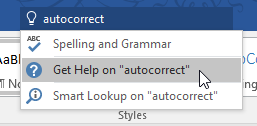
After a brief search, a list of topics appears in the Help window
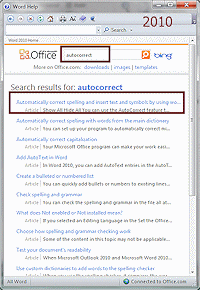
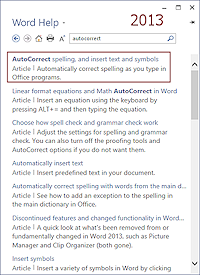
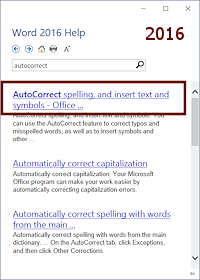
Read all the topics displayed on the page.
(Yes, the whole page, please!)
Notice
the links a short distance down the page, with the down arrows on the left. These are links to
spots on the Help page.
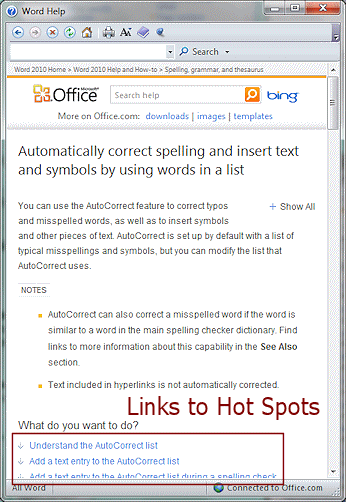
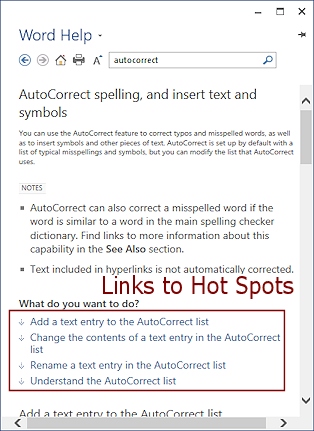
The AutoCorrect dialog has several tabs about things Word can do for you automatically.
We skipped this feature earlier when we looked at the Word Options dialog. It's a bit awkward to get to.
 Click in the Navigation pane on Proofing.
Click in the Navigation pane on Proofing. 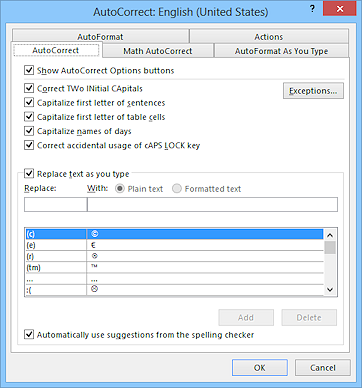 Tab: AutoCorrect - Spelling corrections
Tab: AutoCorrect - Spelling corrections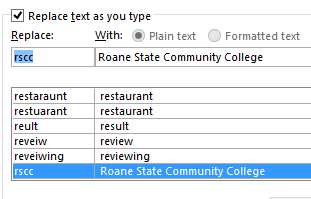 In
the Replace: box, slowly type rscc.
In
the Replace: box, slowly type rscc.In the With: text box, type Roane State Community College. (This is where I used to teach.)
If
you attend this school or work there, this replacement will make
it easier to enter the school name accurately in all of your
documents... IF you enter it correctly here. This same list works in other Office programs, too,
like PowerPoint and Excel. Sweet!
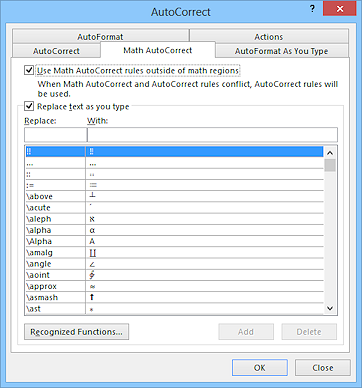 Tab: Math AutoCorrect - Replaces text with math symbols
without having to dig through the Symbols dialog
Tab: Math AutoCorrect - Replaces text with math symbols
without having to dig through the Symbols dialog
Verify that both check boxes are checked.
Scroll the list to see what math symbols are available. What looks good to you? Do you see any symbols that you have seen before?
The
new Math AutoCorrect looks fabulous to me!! You can type \sqrt and get the
square root symbol √ without having to dig through the
Symbols dialog! You have to check the box to use these
corrections in ordinary text to have the most fun.
 Tab: AutoFormat As You Type - Changing the look- bullets, numbered lists, lines, etc.
Tab: AutoFormat As You Type - Changing the look- bullets, numbered lists, lines, etc.Tab: AutoFormat
Be careful about these two
similar tab names!
Verify that all boxes are
checked.
This tab is nearly the same as AutoFormat As You Type. But choices on the AutoFormat tab are not applied
automatically. You have to tell the document to go back and apply
these changes. Pressing the F3 key after you type applies the
AutoFormat choices.
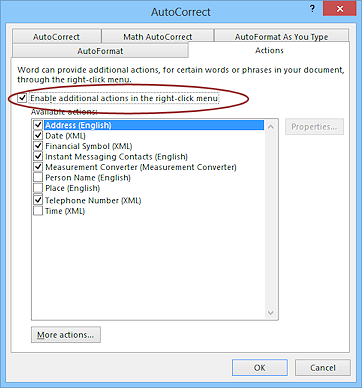 Verify that all boxes
are checked as in the illustration.
Verify that all boxes
are checked as in the illustration.AutoCorrect does more than just changing spelling. A number of AutoFormat changes are part of this feature, like turning a web address into a clickable link, and replacing text, like turning (c) into the copyright symbol ©.

Starting on line 3, type the characters at the right EXACTLY as shown in the image at the right, including a space between each 'word'. Press the ENTER key at the end of each line. The dots in between words show that there is a blank space there.
Watch carefully to see how Word changes what you type.
Click here to open an image in a new window of what you need to type. Use the window's Print command, if you want a printed copy.
Note: After the (tm), those faint double dots are colons.
The AutoCorrect and AutoFormat features change your typing except for the one feature that we turned off earlier - the ordinal number.
What your typing should look like after AutoFormat As You Type does its thing:
What changed while you typed:
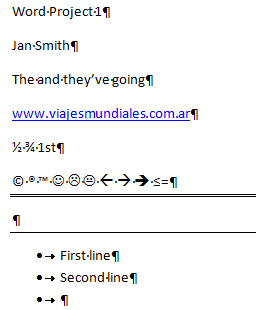 line 3: Spelling corrections
line 3: Spelling correctionsWith your cursor in the last (blank) line, press BACKSPACE once.
This stops the bulleting of the
lines but leaves the indention.
Word sometimes offer you a suggestion in a ScreenTip to complete what you are typing. This come from the Building Blocks feature, which you can access using the Quick Parts button on the Insert tab. You only get a suggestion when the first four characters you have typed matches the unique name of the Building Block. Word comes with a number of these pre-installed to format a header, footer, cover page, table, watermark, table of contents, bibliography. You can add to the list yourself, including AutoText entries for long names that you type a lot, like your school or company name, or even your own full name.
You can accept a suggestion by pressing the ENTER key, or just keep on typing if that's not what you want this time.
 Type a space after the
month and wait for a second.
Type a space after the
month and wait for a second. Whenever Word does something automatically, you have the opportunity to reverse what it did... if you are quick about it.
 Type three underscores and press ENTER.
Type three underscores and press ENTER. Click the down arrow.
Click the down arrow.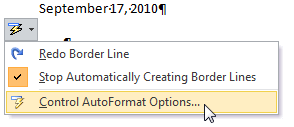 Click on Stop Automatically Creating Border Lines.
Click on Stop Automatically Creating Border Lines.  Click on Control AutoFormat Options....
Click on Control AutoFormat Options....If you have continued typing and later spot a place that Word made a change, you can still undo that change... usually.
 Hover the mouse pointer over the first word
in the third line, The.
Hover the mouse pointer over the first word
in the third line, The. 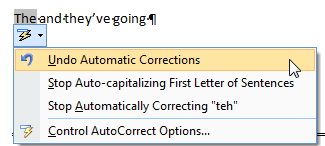 Hover over the blue rectangle.
Hover over the blue rectangle.The choices you made in the dialog AutoCorrect on the tab AutoFormat can be different from those on the tab AutoFormat As You Type. Confusing?? It's all in the timing!
The choices on the plain AutoFormat tab will not be applied until you tell Word to apply them. This is why we put the AutoFormat... command ![]()
![]()
![]() on the Quick Access Toolbar earlier. That command is not on the ribbon
anywhere.
on the Quick Access Toolbar earlier. That command is not on the ribbon
anywhere.
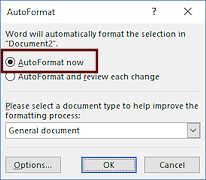 A dialog opens. The default choice is AutoFormat now.
A dialog opens. The default choice is AutoFormat now.You might be asking yourself- why not leave these AutoFormat As You Type choices on all the time? Sometimes it's more trouble than it is worth if Word keeps trying to AutoFormat something that you don't want changed.
For example, if you really want a set of dashes instead of a border, you have to
uncheck the AutoFormat Borders which turns those dashes into a straight line
across the page.
When you save a new document, you see the Save As dialog. You must choose a location, a file name, and a file type. The defaults for this dialog will be the last location used, the first words in the document for the name, and Word document, with extension docx.
![]() Save before printing. It is
a VERY good habit to save your work before trying to print. If something goes terribly wrong with the print job, you certainly want to be able to try again.
Save before printing. It is
a VERY good habit to save your work before trying to print. If something goes terribly wrong with the print job, you certainly want to be able to try again.
![]() Preview before printing! It is
VERY important that you preview every document and view all of its
pages before you print. Many, many pages of paper have been wasted by printing without looking to see exactly what will be printed.
Preview before printing! It is
VERY important that you preview every document and view all of its
pages before you print. Many, many pages of paper have been wasted by printing without looking to see exactly what will be printed.
Name the document mysymbols-Lastname-Firstname.docx , where you substitute your own first name and last name in the file name.
Note: We will not use spaces in file names in these
lessons because some of you may be submitting your documents to a
teacher electronically. Windows and Office programs don't have trouble
with spaces in names, but some course management programs refuse to
work with file names that include spaces.
Click on ![]()
![]()
![]() the Print Preview/Print Preview & Print button on the Quick Access Toolbar.
the Print Preview/Print Preview & Print button on the Quick Access Toolbar.
![]() Word 2007: The Print Preview window appears.
Word 2007: The Print Preview window appears.
![]()
![]()
![]() Word 2010, 2013, 2016: The Backstage view opens to the Print page. The preview of the document is on the right. The pane has several controls for managing what prints and how it prints.
Word 2010, 2013, 2016: The Backstage view opens to the Print page. The preview of the document is on the right. The pane has several controls for managing what prints and how it prints.
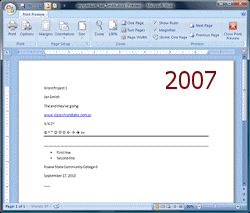
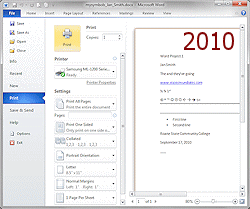
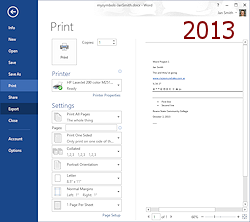
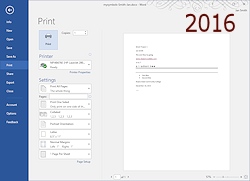
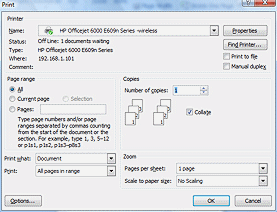

A green check mark on the printer's icon means that this is the default printer.
Sometimes you want to close a document but not close Word itself. If you already have two or more document opened in Word, you can just close the document's window and the other document stays open. But when there is only one document currently open in Word, you must be careful.

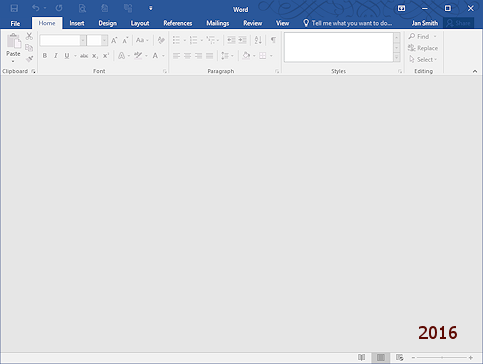 The document closes but Word is still open. The document area is empty.
The document closes but Word is still open. The document area is empty.
I found a Microsoft Knowledge Base article that helps: http://support.microsoft.com/kb/926927/en-us?FR=1
The title of the article says 'from one computer to another' but the last part of the article actually discusses moving autocorrections from an earlier version into Office 2007.
This is not for the faint of heart! You have to have hidden files showing and be willing to rename hidden files, etc. If you plan to do this, do it before you add any new corrections on the new computer or new version of Office. Those entries would be lost since you are not adding to the list but are replacing the list with your old list of corrections.